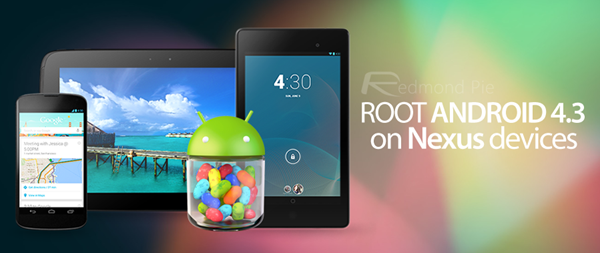Android 4.3 came to life for Nexus devices earlier last week, and since then, it has received significant attention. For those lucky owners of these devices, the new version of Google’s smartphone and tablet operating system has a lot to offer, and then some more, in terms of fixes and improvements. Now that all of that’s settled and done, and the code has been rolled out to AOSP, it’s time for modifications and developer-community-driven enhancements.
Of the last category, the first are foremost that comes is rooting, i.e., gaining superuser access for your device. Luckily, thanks to developers such as Chainfire, that’s already pretty doable on the likes of Nexus 4, 7, 10, and Galaxy Nexus. In this article, we’ll guide you how to root Nexus 4, Nexus 7 (2012), Nexus 7 (2013 – unstable), Nexus 10 and Galaxy Nexus running Android 4.3 Jelly Bean.

Before we begin, please note that you follow these instructions at your own risk. While tested and proven safe, any resulting damage to your device from following this procedure is on you. We cannot be held liable for a bricked/damaged device.
For the sake of this guide, we’ll be using two different methods. The first one uses Chainfire’s Auto Root that’s more suited for the Nexus 7, while the generic flashing of custom recovery and SuperSU for the rest of the devices.
Root Nexus 7 (Wi-Fi & 3G) using CF-Auto-Root
Requirements:
- CF Auto Root package for Nexus 7 Wi-Fi [download] / CF Auto Root package for Nexus 7 3G [download]
- Android USB driver for Nexus 7 installed on you computer.
- USB Debugging enabled on the device.
- 80% or more battery power remaining on the tablet.
- Set up Android ADB and Fastboot on Windows.
Please note that these instructions are for carrier unlocked variants of Nexus 7, and will work only on Nexus 7.
Procedure:
Step 1: Extract the downloaded CF-Auto-Root package and keep the files in a convenient location on your machine.
Step 2: Reboot the Nexus 7 into fastboot mode using the combination of volume up, volume down and power buttons.
Step 3: Once in fastboot, connect the device to the PC using the supplied USB cable. Wait for the fastboot drivers to configure themselves.
Step 4: Navigate to the folder where the downloaded files from CF Auto Root were extracted, and look for the file that says “root-windows.bat”. Double-click to run it.
Step 5: Follow the on-screen instructions until you reach the point when the tablet reboots back into normal mode.
There you have it – your Nexus 7 on Android 4.3 is now rooted. You may verify that by going to the app drawer and looking for SuperSU app.
Root Nexus 4, 10 and Galaxy Nexus using SuperSU
Requirements:
- Android SDK configured on your computer
- Custom recovery like ClockworkMod or TWRP which you can flash using the Nexus Root Toolkit.
- Nexus 4, 10 or Galaxy Nexus with unlocked bootloader which you can have using the Nexus Root Toolkit mentioned above
- SuperSU 1.50 by Chainfire [download]
Procedure:
Step 1: Download the SuperSU ZIP package and transfer it to the root of your device.
Step 2: (Optional) If you don’t have a custom recovery installed, do it now using your preferred method (ideally you’d want to do that via fastboot).
Step 3: Boot the device into recovery and flash the SuperSU ZIP file.
Step 4: After you’ve flashed the superuser package, wipe cache and dalvik cache, just to be on the safe side.
Step 5: Reboot.
That’s it – your Nexus 4, 10 or Galaxy Nexus is now running rooted Android 4.3.

It’s worth noting that while this same method can be used for Nexus 7 as well, it’s more safe and reliable to use CF-Auto-Root for that tablet, since Auto-Root is free from firmware limitations and will pretty much work on any version of Android for Nexus 7.
You can follow us on Twitter, add us to your circle on Google+ or like our Facebook page to keep yourself updated on all the latest from Microsoft, Google, Apple and the Web.

